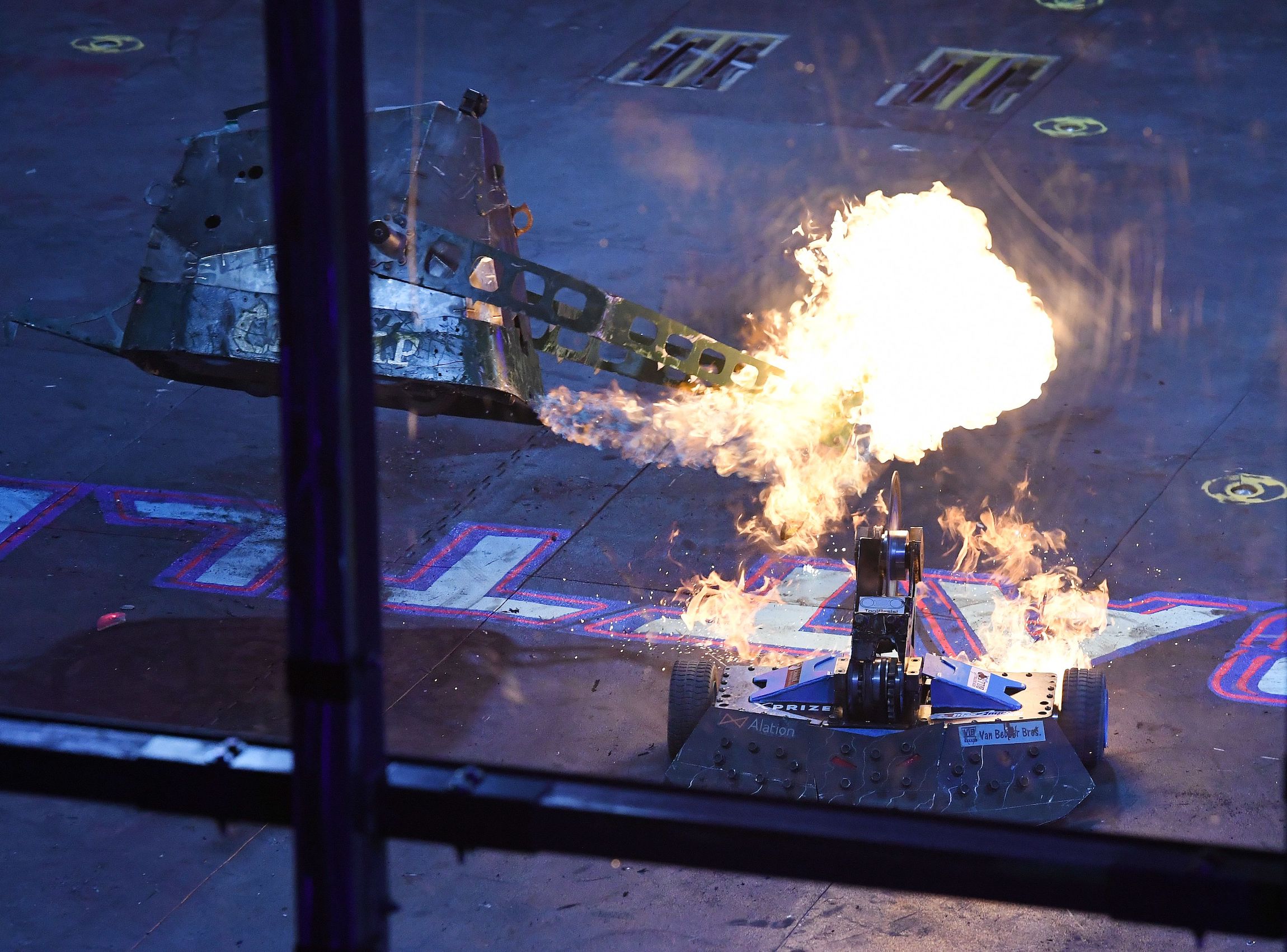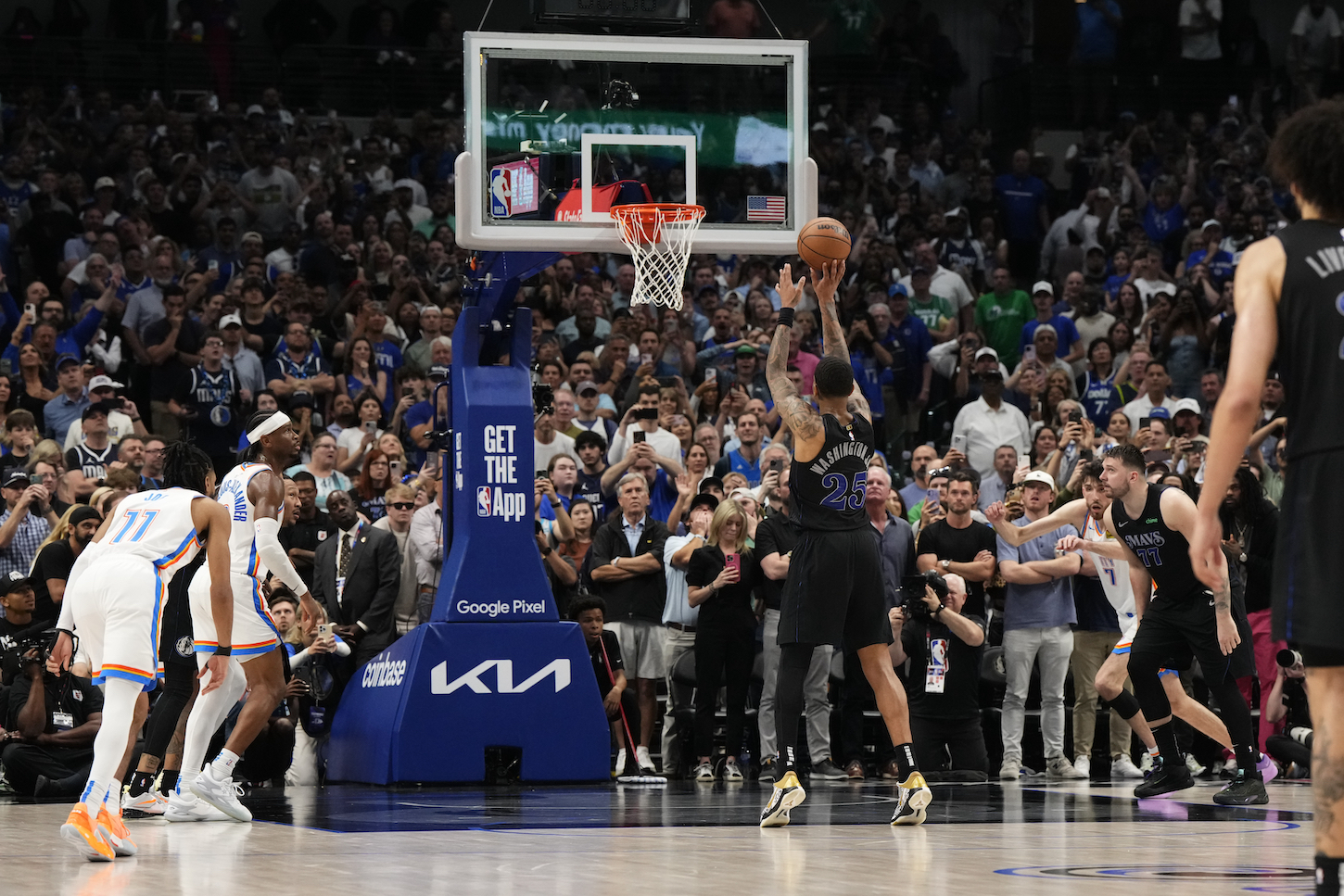In Slack we were talking about BattleBots—totally normal workplace behavior, not what this blog is about, this conversation is over—and suddenly it dawned on me that I had named, like, 20 different battlebots. A frankly kind of alarming number of battlebots for a just-about-42-year-old non-roboticist to know by name. Opinions were bubbling up out of me: why the more elaborate bots tend to get wrecked by the simpler, more elegant ones; the value of fire as a secondary weapon; which edition of Chomp was the best. I was recalling the tactics of specific bot ... drivers(?), and memorable moments from specific matches. I guess I had not thought to regard myself as a BattleBots sicko before this, but also I think I can no longer deny being one.
BattleBots—not the long-dead Comedy Central series, but the far better version resurrected on the ABC network in 2015 and then ported over to the Discovery Channel in 2018—was a deep-pandemic infatuation in my house, but unlike sourdough or watching the OTB feed of horse races, a deserving one: It's a good time. Robots, mangling each other! Robots sometimes exploding or flying apart! Hell yeah. We on-demanded every episode of every edition of the show we could find, at least once. My kids have a handful of teeny little radio-controlled bot replicas, and a mini arena for warring them against each other, all of which they've outgrown. Somewhere along the way I seem to have absorbed more information about and developed more thoughts on BattleBots than I'd realized. Anyway here are some battlebots that I like.
SawBlaze
As a rule, circular saws are not terribly effective bot-battle weapons, at least when judged on the actual damage they inflict. Compared to the type of hard-hitting weapon that transforms rotational force into a huge percussive smack violent enough to knock the wheels right off an opponent or jar loose its internal workings, the saw is a much slower option requiring infinitely greater precision. A saw is not going to send a several-hundred-pound robot flipping and flying across the arena, or smash its weapon-arm right off in a somehow-gory-seeming explosion of metal fragments and shredded rubber tubing. Best-case scenario, the saw-bot manages to immobilize its opponent against a wall, and uses the saw to cut through something sensitive. That's low-odds stuff.
But also, I don't give a damn! Saws are cool and evil. When you were a kid and you pictured rampaging murder-bots, they probably had circular saws for hands, or else you were imagining them wrong. In Who Framed Roger Rabbit?, when Judge Doom is at his absolute most terrifying, he is coming toward Eddie Valiant with a giant shrieking circular saw at the end of his arm. You get the idea. When the saw digs into the metal of an opposing bot, the sound is from hell and the shower of sparks is incredible. SawBlaze doubles the saw's coolness with a flamethrower—another not-very-effective weapon—and then triples the coolness by having the flamethrower spew green frickin' fire. Green fire! For my money there is no BattleBots weapon combination half as cool as a circular saw plus green fire.
Gigabyte
On the other hand, coolness schmoolness. Gigabyte is the precise polar opposite of SawBlaze: a dumb circle, with, like, some stuff sticking out of it, that just kinda spins around—real fast, if it gets time to spin all the way up to speed before impact—and hopes to do more damage to the other bot than to itself. It rarely does. Mostly when I think of Gigabyte I think of it getting its weight distribution screwed up by the first hit it delivers, and then flopping around ridiculously with each rotation, and then getting pounded into inoperability by whichever bot it's facing. It's very funny. I love Gigabyte and would never root against it.
The earliest iteration of BattleBots had a confounding problem: Everybody wanted to see ambitious futuristic engineering and sophisticated Terminator-ass robots with, like, tank-tread legs and laser cannons and shit—Johnny 5 from Short Circuit, basically—but all the fancy bots routinely got their shit wrecked by bots that were literally just a wedge with wheels. All that mattered was the wedge's ability to do—"do" is generous, here, perhaps falsely implying activity—two things: deflect blows harmlessly off its sloped surface, and slip under other robots, flipping them onto their sides. As a satire of the American tech industry, this could not be improved upon; as television, it sucked. Moreover it kind of made the whole "bot" part of the concept a lie: For all practical purposes, the competition centered on radio-control car driving, and the presence of robotics acted as a weakness.
Rule and format changes did away with the simple wedge-bot, thankfully. Gigabyte (along with similar "full-body spinner" bots like Captain Shrederator) is about as conceptually unsophisticated as the bots get in recent seasons, with the important difference that full-body spinner bots, unlike the wedges, are great television, because of their capacity to deliver huge blows. I find it delightful. It's just so dumb! And the self-righting L-bar thing sometimes looks like it is blowing backward in the wind.
Bronco
Bronco was another fairly basic concept: With its sloped sides and, uh, spatula thingy, it was good for getting under the opposing bot, similar to the annoying wedge-bots of yore—but then, once it got under there, Bronco had a big powerful pneumatic flipping arm that would launch the other bot into the air, often end-over-end and always with spectacular violence. Watching Bronco toss some bot all the way out of the playable area of the arena, you could forget that these are several-hundred-pound metal machines in some cases roughly the size of a two-stage snowblower. That's cool.
A fun wrinkle was that, due to the nature of pneumatics, Bronco could only fire that flipper a limited number of times during a given match, after which it'd be largely helpless. Also it was gigantic, not especially mobile, and couldn't do the zero-point turning some of the other bots could do, so a Bronco match presented a fun tactical battle, the opponent looking for opportunities to slip around to Bronco's sides and attack its (sometimes fully exposed, sometimes minimally armored) wheels and Bronco looking for just one moment of sloppy driving that would allow it to slide that flipper under there and send the other bot pinwheeling into hell.
Chomp (second edition)
Chomp went through a few iterations over the years, all of them famously sophisticated compared to the other bots and none of them very successful at the battling part. The first Chomp was a crusher, and sucked and isn't really worth discussing. The third and most recent Chomp was a very cool but nearly totally immobile walking bot with six short, spidery robotic legs and virtually no hope of ever so much as hitting any opponent that did not suffer a spontaneous total power failure directly in front of it. My favorite Chomp was the second one, a very silly top-heavy guy that attacked with a combination of a hammer arm and a showy flamethrower. Every time it fired its hammer, it would catapult itself into the air, land on its side, and then have to kind of flail around stupidly in hope of accidentally righting itself again. I loved it.
The BattleBots competitors operate under weight limits, which introduce some fun trade-off decisions. To make your weapon more powerful, either by sizing it up or by giving it a more powerful motor, you have to scale back either your armor, making your bot more vulnerable, or the bot's drive machinery, making it slower and more vulnerable. For all the changes that did away with the miserable wedges, even in more recent seasons the very most successful bots (we'll get to one of them in a bit) are characterized by a certain brutish simplicity, which enables them to put all of their power—all of the heavy stuff that generates power—into a single devastating weapon. Chomp's creators, to their great credit, went in the complete opposite direction: The second Chomp, the one in the video up there, was built with a fancy and probably totally needless internal guidance system, allowing it to detect a nearby opponent, steer to face the opponent, and fire its hammer, without any human input. The trade-off for all that extravagance is that, by all appearances, its hammer arm was made of rolled-up tinfoil. Even a direct hit never seemed to do even the slightest damage, except to the arm itself, which would bend the first time it whacked anything. And housing all of that extra stuff doomed Chomp to its tall profile; it was just about the only bot that could ever fall onto its side, and it did, all the time.
All of this combined to make second-edition Chomp extremely easy to root for: It was the dopey armadillo guy spewing fire all over the place and flipping itself in the air in its zeal to pound fruitlessly on somebody with its featherweight weapon. That's just a charming thing to be.
Blacksmith
Blacksmith was like a somewhat more pragmatic-minded version of Chomp: a hammer, yes, and fire, yes, and a kind of dopey body that makes me think, somehow, of a small mammal, but without the preposterous guidance system and with the ability to swing its own hammer without throwing itself into the air. Like Chomp, it wasn't all that good and mostly didn't win. But, look, man, "hammer that spews roaring fire" is just a very cool concept.
My kids had the toy Blacksmith and it was fun to drive that lil' guy around making him hammer stuff, even if the toy one didn't shoot fire.
Tombstone
Tombstone, one of the most famous of the bots, is an example of the enforced engineering trade-offs managed to ruthless efficiency. Tombstone is not fast or agile. It features virtually no armor. Its wheels are totally unprotected in all configurations. It is just a simple pipe frame, almost comically simple. It gives nearly all of its resources to powering a single uniquely devastating weapon: a huge horizontal spinner that, once it gets powered up, annihilates anything it contacts. Tombstone's defense consists pretty much entirely of its ability to turn itself in a zero-point circle, to get that spinner between its body and the enemy.
On the one hand, that kind of sucks. At least theoretically some of the appeal of BattleBots to the layperson comes from the idea of, y'know ... robots. Machines that can do impressive or cool things, like flying or operating a complex arm-like apparatus or traveling through time to prevent the birth of a resistance leader. Using a bicycle chain to rotate a big block of metal isn't really robot shit, and every time Tombstone shredded some comparatively ambitious opponent, it felt slightly dirty. On the other hand, the violence was incredible. A full-power Tombstone hit would fuck up both robots, spectacularly. Its operator, the knowing heel Ray Billings, would do a thing where he'd turn Tombstone away from an opponent, exposing his bot's vulnerable wheels, effectively daring them to try to get into Tombstone's guts before he could whip that spinner back around and rip their shit in half. Opponents could hardly decline such an offer: Taking out just one of Tombstone's wheels would win the fight, and a frontal attack would be suicidal. It almost never worked. In fact, when Tombstone lost, it usually was due to the violence of one of its own blows. This made Tombstone a great villain.
One of the great BattleBots moments happened when Tombstone faced a much smaller and poorly functioning bot called Tantrum, which featured metal fists on either side of its body. Tombstone, circling the all-but-helpless Tantrum, got its spinner all the way up to speed and then whacked Tantrum so hard that one of those metal fists flew off at speed sufficient to embed itself in the plexiglass wall of the arena, one of the few times the festivities seemed actually dangerous to the people in attendance.
Hell yeah.
Huge
Huge had gigantic wheels made of foam that would simply bend away from blows instead of breaking, and its body was too high in the air for the most popular bot profile (low and wide with a spinner in front) to reach. The only way to really damage it was to absorb a blow from its whirring vertical spinner and hope the energy twisted Huge's body apart (which it sometimes did). That's just so stupid and wonderful. Foam wheels! Also the bot was named "Huge." That makes me giggle.
Duck
It was never quite clear exactly how Duck (styled DUCK! by its creators) was supposed to damage opposing bots. One of the judging criteria on BattleBots, when a match ended without a knockout, was supposed to be how effectively either bot used its primary weapon—and Duck didn't even seem to have one. It just had this hopeless little duckbill sticking out of the front of its otherwise featureless body. I guess maybe in theory the bill could get under opponents and lift them? But also it never did that. Duck's creators had found a third extreme, somehow opposite both Chomp's technological extravagance and Tombstone's all-offense brutishness: All of Duck's resources had gone into making it quick and sturdy. It won, in the rare cases it won, by simply hanging in there until the other robot exploded its own weapon or drivetrain trying to knock it out.
That is very foolish! But also Duck was the project of a family team headlined by a nerdy middle-aged guy and his young daughter, and that is sweet.
Free Shipping
Speaking of things that were never quite clear, it was not apparent how Free Shipping, my favorite battlebot, was supposed to win a match, or if it was even made with winning a match in mind, or whether its creator, the affable Gary Gin, even knew or cared that there was a competitive aspect to this whole thing. Chomp's weight went into sophisticated electronics; Tombstone's went into a huge weapon of unrivaled destructive power; Duck's went into stout armor; Free Shipping's creator, by all appearances, left like 200 unused pounds on the workshop table and was like "This is fine."
In every way a bot could be optimized for battle, Free Shipping was not. An ideal bot would be squat and wide with a low center of gravity; Free Shipping was tall and narrow. An ideal bot would be abundantly armored, especially around the wheels; Free Shipping was not armored at all. An ideal bot would have a strong body that could withstand blows from heavy metal bars traveling at deadly speeds; Free Shipping was very obviously flimsy and held together with staples. An ideal bot would feature a powerhouse weapon that did not require a ton of precision to use; Free Shipping had a weapon in name only, an all-but-useless forklift that bent into a pretzel the first time it came into contact with basically anything. An ideal bot probably would not light itself on fire a lot, or ever; Free Shipping pretty much invariably turned itself into a ball of flame with its own hapless flamethrower.
Every Free Shipping match was a joy. At some point in each one of them Free Shipping would be careening around the arena half-shattered and fully on fire, dragging its mostly detached forklift behind it like a little dead waterskier, maybe occasionally trying to whip it around at the unscathed opponent in a vaguely weaponlike manner, and the goofy announcer guys would start singing hosannas to Gin's remarkable driving skill. That's only when Free Shipping didn't melt its own circuitry at the moment of its burst into flame, which it usually did. This is the most I have ever been able to relate to any character on television.





